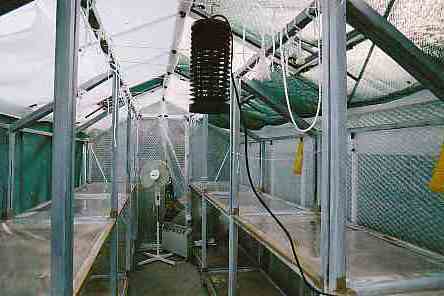MY COLLECTION IN SUMMER AND IN WINTER
photo 5/8
Now, some words about the inside installation, which
was designed to growing epiphytic cacti most of which I cultivate in hanging
pots.
Concerning thermal insulation inside the greenhouse, as well on the
vertical walls as on the walls of the roof, I fixed a bubble plastic sheet
of horticultural type, treated not to deteriorate in contact with the ultraviolet
rays. I fixed this sheet in a reversible way by using special clips stuck
to the glass walls. The performance of this system has been excellent for
several years ; I found all the parts at a moderate price at a horticultural
wholesaler’s.
As regards protection against the excessive sunning,
I use the same clips as previously mentionned to fix shade cloths which
I sometimes move according to the aspects of the plants; the green shade cloths
give more shade and white ones give a lighter shade.
The tables where I place the pots and the structure I hang them on to
are of personal design, with the precious help of a mechanic friend of mine!
The frame is made of steel square tubes (4 mm x 4
mm) ; the six tables which we can see on the photograph were arc welded,
then fitted into each other to enable them to be separately brought in and
out of the greenhouse ; they are surmounted by more tubes to hang pots on
to; these tubes fit into those of the tables. I tighten rot-resistant cords
on and between these tubes, and I hang pots on these cords.
The tables are also made of chipboards treated against moisture
which I covered with a thick oil-cloth not to wet them when I sprinkle.
The greenhouse is heated by two electric convectors of 2kW each located at both ends of the greenhouse and connected to sockets fitted with a room thermostat. Next to these convectors I put two electric fans to circulate the air in the greenhouse. But, for two years, we have had power cuts in the area which made me several times dread losing all my plants very quickly. Thus, as a precaution I bought NONELECTRONIC kerosene heaters i.e. not requiring the use of electric power; they are ready to work in case of a prolonged power breakdown.
In winter too, epiphytic cacti have predators : small flies which prick the stems, as well as the dreadful nocturnal caterpillars (cutworms). I trap most of flies with small orange coloured rectangles of sticky fly paper and I fight against caterpillars with two anti-mosquitos lamps which work with fluorescent tubes of blue light. The moths, from whose eggs caterpillars stem from, are attracted by the blue light and burn their wings against the electrified nettings located in the lamps, near the tubes ; we can see one of these lamps, of black color, in the foreground of the photograph.
_________________________________________________________________________
THE WATERING INSTALLATION OF MY COLLECTION
______________________________________________________________
____________________________________________________________________________________
